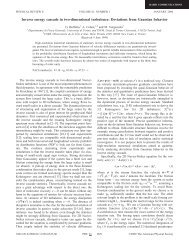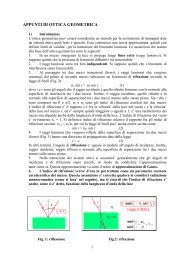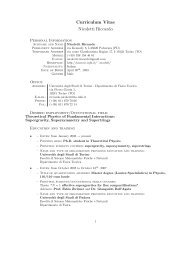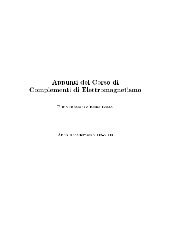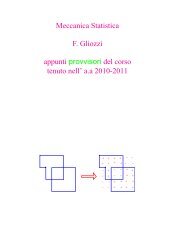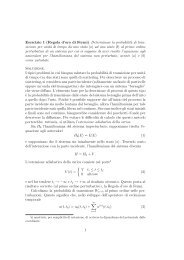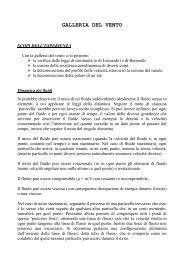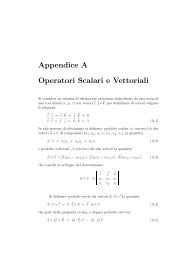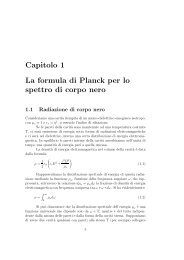Lezioni di Meccanica Quantistica Relativistica A. Bottino e C ... - INFN
Lezioni di Meccanica Quantistica Relativistica A. Bottino e C ... - INFN
Lezioni di Meccanica Quantistica Relativistica A. Bottino e C ... - INFN
You also want an ePaper? Increase the reach of your titles
YUMPU automatically turns print PDFs into web optimized ePapers that Google loves.
Nella scrittura <strong>di</strong> queste equazioni abbiamo fatto uso delle unità (razionalizzate) <strong>di</strong>Heavyside-Lorentz; in queste unità si haα =e24πc = e24πNotiamo due importanti proprietà:in unità naturali . (4.6)1. La natura antisimmetrica <strong>di</strong> F µν implica che la quadri-corrente j ν è conservata: infatti,dalla (4.5a) si ottiene∂ ν j ν = ∂ ν ∂ µ F µν = 0 . (4.7)2. In virtù della definizione (4.2), F µν ≡ ∂ µ A ν −∂ ν A µ , l’equazione (4.5b) è identicamentesod<strong>di</strong>sfatta.Espressa me<strong>di</strong>ante il quadri-potenziale A µ , l’equazione (4.5a) <strong>di</strong>venta□A ν − ∂ ν (∂ µ A µ ) = j ν . (4.8)4.2 Interazione elettrone–campo elettromagneticoClassicamente, per passare dalla trattazione <strong>di</strong> un elettrone libero a quella <strong>di</strong> un elettronein interazione con un campo elettromagnetico si applica la cosiddetta prescrizione <strong>di</strong>accoppiamento minimo, ossiap µ → p µ − e c A µ , (4.9)dove e è la carica elettrica dell’elettrone. La regola quantistica corrispondente èossia (in unità naturali)Per l’operatore <strong>di</strong> Dirac i/∂ − m si haˆp µ → ˆp µ − e c A µ , (4.10)∂ µ → ∂ µ + i e A µ . (4.11)iγ µ ∂ µ − m → iγ µ ∂ µ − e γ µ A µ − m (4.12)e quin<strong>di</strong> l’equazione <strong>di</strong> Dirac in presenza <strong>di</strong> un campo elettromagnetico esterno <strong>di</strong>venta(i /∂ − e /A − m) ψ(x) = 0 . (4.13)4.3 Invarianza <strong>di</strong> gaugeData una soluzione ψ(x) dell’equazione <strong>di</strong> Dirac, anche una generica ψ ′ (x), ottenuta dallaψ(x) per una ridefinizione della fase, ossiaψ ′ (x) = e iα ψ(x) (4.14)37




